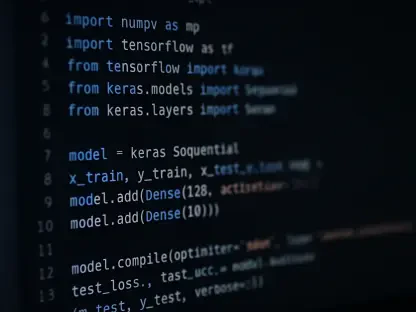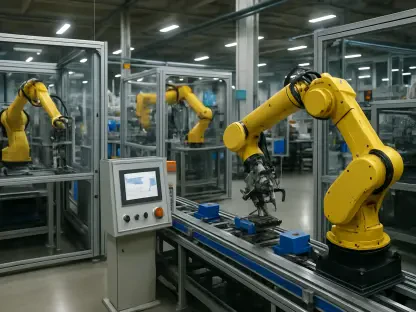Megan Clairmont sits down with Anand Naidu, our resident Development expert specializing in both frontend and backend technologies, to delve into the exciting capabilities of the newly launched VAST AI Operating System. With his deep knowledge of coding languages and computing architectures, Anand provides valuable insights into how this platform could propel AI innovation forward.
Can you give us an overview of the VAST AI Operating System and its primary purpose?
The VAST AI Operating System is crafted to drive the next chapter of AI innovation. It’s designed to harness the power of modern AI infrastructure and unlock AI’s full potential at scale. By integrating various elements like data, compute, and messaging in a unified platform, it stands alone in democratizing AI access and processing real-world data efficiently.
What is the Disaggregated and Shared-Everything (DASE) architecture, and how does it benefit AI and analytics workloads?
DASE architecture enables parallelization of workloads, which means AI and analytics can be processed simultaneously, making it incredibly efficient. It federates clusters into a unified computing and data cloud, which supports over a million GPUs globally, ensuring that data-intensive environments operate seamlessly.
How does the VAST AI Operating System unify disparate legacy IT technologies?
The platform does not just aggregate various technologies; it actually creates a new substrate that integrates all components like data, compute, and messaging into a modern framework. This makes it easier to capture and enrich data with real-time AI-driven context, unifying legacy systems into a cohesive, intelligent workflow.
What does VAST mean by a “Thinking Machine,” and how does the platform achieve this concept?
A “Thinking Machine” in VAST’s vision is a system that does more than just store and process data; it understands and reasons with it. Through integrated architecture, the platform captures real-world data, enriches it with AI-driven context, and executes intelligent workflows that bring about a deeper understanding and reasoning capability.
Renen Hallak mentioned the platform is built around the concept of agents. Could you elaborate on how this agent-centric approach works?
The agent-centric approach shifts focus from traditional applications to AI agents. These agents operate across public and private clouds, performing tasks like real-time event processing and messaging. They offer a flexible runtime that supports the deployment and operation of AI tasks on a global scale.
What are the main components of the VAST AI Operating System’s agent-centric approach, such as kernel services, real-time event processing, and messaging infrastructure?
Key components include comprehensive kernel services for platform management, real-time event processing for prompt action, and robust messaging infrastructure for seamless communication. All these work together to provide a platform where AI agents thrive independently yet collaborate effectively.
Tell us about the VAST AgentEngine. How does it bring AI models and agents to life?
The AgentEngine operationalizes AI models and agents by providing a low-code environment. This allows users to build workflows intelligently, select appropriate reasoning models, define tools for agents, and enable AI to perform complex reasoning tasks efficiently, turning abstract models into active problem solvers.
How does the AgentEngine’s low-code environment support users in building intelligent workflows?
It simplifies the development process, allowing even those without extensive coding experience to harness AI’s power. Users can create robust workflows by selecting models and defining agent tools, facilitating complex tasks without needing to engage in extensive programming.
Can you explain the functionality of the new AI agent tool server within the AgentEngine?
The AI agent tool server enables agents to access and invoke various data types, functions, and other agents as needed. This capability ensures agents have secure, real-time access to a breadth of resources, contributing to a more dynamic and responsive AI ecosystem.
How does the VAST AI Operating System ensure secure, real-time access to various tools and systems for agents?
Security is woven into the platform through the use of agents with unique personas and credentials, which allows controlled and secure access to different systems and tools. This is crucial for maintaining integrity and reliability in real-time operations.
What features of the platform’s scheduler and fault-tolerant queuing mechanisms contribute to its resilience?
The advanced scheduler and fault-tolerant queuing allow the system to manage tasks efficiently and continue operation even when components fail. This ensures that workflows are robust and dependable, making the platform extremely resilient.
Could you describe the platform’s agentic workflow observability and its benefits for developers?
The platform provides massive scalability and observability, allowing developers to track workflows across distributed systems easily. This transparency helps identify bottlenecks and optimize processes, enhancing the overall efficiency of AI-powered tasks.
What types of open-source agents will be included with the VAST AgentEngine, and what use cases will they address?
VAST AgentEngine will include a variety of open-source agents, each targeted at specific use cases, such as a reasoning chatbot for leveraging organizational data, an editor agent for content creation, or a compliance agent for regulatory enforcement. These are designed to meet both industry-specific and general-purpose needs.
How does VAST plan to facilitate the adoption and development of the VAST AI Operating System among users?
To increase adoption, VAST will conduct global workshops offering hands-on training and guidance. These sessions will help users become familiar with the platform’s components and learn how to deploy solutions effectively, paving the way for extensive developer engagement.
In what ways does the VAST AI Operating System aim to drive AI-driven business transformation?
The platform is designed to empower businesses by providing cutting-edge tools to innovate and optimize processes through AI. By unifying sophisticated infrastructures into a single platform, it enables teams at all levels to make data-driven decisions, ultimately transforming business operations to be more intelligent and efficient.









